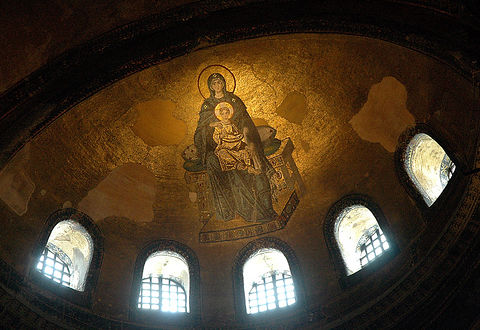 Mother of God and Child, Hagia Sophia, Constantinople.
Mother of God and Child, Hagia Sophia, Constantinople. If we look at the lives or the works of Western Christians during the so-called "Dark Ages", the period from about 450 to 1050, we are invariably struck by their intellectual and cultural weakness their unformed, immature, even crude, theological outlook. Whereas in the third and fourth centuries we are able to find great Fathers (Blessed Jerome, Blessed Augustine), making their theological contribution to the development of Orthodoxy in the West, and also those who were working to spread the influence of Eastern Orthodoxy in the West (St. Hilary of Poitiers, St. Martin of Tours, St. John Cassian), in the sixth to eleventh centuries, there is a breakdown in the intellectual and cultural growth of the West. There are few indeed at this time who can stand comparison with the great mystical theologians of the East, where the great Ecumenical Councils were held and where the Faith was being formulated. Rome itself fades as an intellectual centre at this time. The light of knowledge was kept in distant places, by St. Isidore in Spain, Bede the Venerable in Britain, Irish Christians, some of whom knew Greek. Their knowledge, however, was vastly inferior to that of the Eastern Fathers, and a man like John Scotus Erigena, who translated some of the 'Pseudo-Dionysius' into Latin in the ninth century, stands out like a beacon in the darkness of ignorance. The holy men and women of the West in the 'Dark Ages' are as different from the great Egyptian, Syrian and Greek mystics of the multi-cultural Orient as Carolingian or Anglo-Saxon iconography is from post-iconoclast Byzantine iconography. Yet, although there were social, political and economic divergences between East and West, the Church was One. There were local, cultural variations in the practice of the Faith, but at heart Christians were united in their confession of the Orthodox, Catholic Faith. The East was a new and flourishing foundation, intellectually and culturally climbing to its zenith, the West was a fallen Empire, isolated by the Mohammedans from the cultural riches of Constantinople. The West was politically crippled by pagan onslaughts and invasions, living without a great cultural or intellectual awareness of the Faith and searching anywhere for political and military support against its enemies. It was even willing to crown a Frankish king and set up a Western Empire for the sake of self-protection. Spiritual unity, however, remained.
Differences in customs had arisen even in the first centuries. The East, by culture and by history, was more inclined to mystical contemplation and philosophical speculation. The West, on the other hand, was renowned for practical legislation and government. Moreover, after the Fall of the Empire in the West, it found itself in ever greater need of such qualities. The religious and political stability of the See of Rome depended on the activities of governors, overseers, confessors and missionaries to the heathen who had inundated the West. The West required kings and queens of devout life to bring order and protection to its lands from the foes of Christianity. The East, in contrast, lived in a more stable situation at this time. The seat of the Christian Universe had been fixed in New Rome, the City of Constantine. This City was the centre of theology, art, architecture and churchmanship. All its inhabitants had officially been received into the Church. Men and women had as a result retreated into the desert to form monasteries to pray for the world and the Church of Christ on earth, which now teemed with new converts who were so often Christian in outward form only.
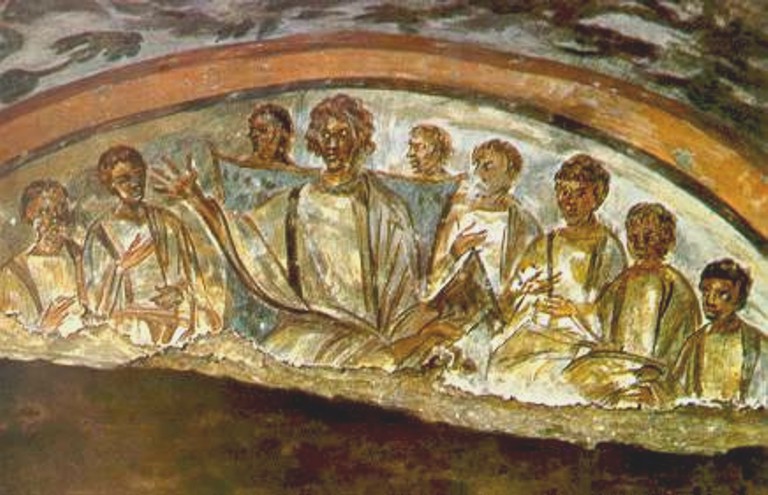 Christ Among the Apostles is in an arcosolium of the Crypt of Ampliatus in the Catacombs of St. Domitilla in Rome.
Christ Among the Apostles is in an arcosolium of the Crypt of Ampliatus in the Catacombs of St. Domitilla in Rome. The West lived in an entirely different situation. It had yet to win great spiritual, military and political battles before it too could become fully part of the Christian Empire. Understandably the Church in the West was willing to give its religious sanction to any newly-baptized Franks or Teutons who were prepared to defend it against the heathen. Christendom was not, however, divided into two in this respect. There were, for example, great ecclesiastical administrators in the East, and they needed to be great to protect their Patriarchates from the usurpations and claims of the Emperors and heretics. And in the West there was a great, monastic movement, which had spread from the tens of thousands of monks in the Egyptian desert to Italy, Southern Gaul and up through Europe to Ireland. There were great mystics and saints. We think of the Celts, with hundreds of hermits and holy bishops, the most famous of whom are perhaps Sts. Patrick, Columba, Columban and Aidan. We think of Anglo-Saxon saints such as Sts. Cuthbert and Guthlac whose lives read like those of the desert-fathers. We think of the great influence of the Eastern-inspired Rule of St. Benedict. We think too of the multitude of Anglo-Saxon and Frankish hermits and hermitesses, great abbots and abbesses, bishops, princesses, holy kings and queens; Sts. Edmund and Edward the Martyr, for instance. Yet, although these were all holy people, many of them were illiterate, unrefined, they were insufficiently educated to express their mystical experience in works of theology, as could the great Eastern saints.
The hiatus between the early and undeveloped culture of Christian Rome and the growth of a new Western Christian culture, between, in other words, the fifth and the eleventh centuries, signified the formation of a different cultural ambience in the West from that in the East. The Christian West did not have the time to Christianize the pagan, classical culture of Rome, whereas the East made a new start. The intellectual and cultural world of the West was thus left open to anyone who could successfully Christianize and sanctify it, thus appropriating and sacramentalizing it for the glory of God and the use of the Church. And at this time this work was left undone, the classical culture of pagan Rome lay for the most part ignored. In the meantime the cultural and artistic needs of the West were provided for by Constantinople. Eastern iconography, architecture and art, Christianized, depaganized, flooded into the West, mainly through Italy and Sicily, and radiated out through the Mediterranean lands and up through the North. However, beneath this process, the intellectual and cultural spheres remained unchanged, theologically unassimilated and undeveloped. The Art of Eastern Christendom was the product of Eastern Theology alone, and the West received only the Art, not the Theology. For linguistic, geographical and other reasons, the intellectual and cultural world of the West was not taken up in the processes of spiritualization, of divinization, which had brought a complete harmony of wholeness and unity to Eastern Christian thought and culture. The Western heart was Christian, but the head remained ignorant. Although the Orthodoxy of Western Christendom cannot seriously be held in doubt in this period, it can be said that the East was in a much more developed, advanced stage in the growth of the fullness of Christian culture. For this reason we are able to perceive a culturally and intellectually qualitative difference between the East and the West in these centuries. Indeed the West was unable to bring any deep, theological prowess to problems which the East had already resolved, especially in iconography.
The rise of the reformed Papacy in the second half of the eleventh century, after a period of shocking corruption, brought about the opportunity to look back to the Ancient World and to consider the theological and intellectual problems of Christianity. Unfortunately, the problems were looked at in the light of pagan logic, the philosophy of the Ancient World. And the theology that was produced as a result was an artificial one, not a living one, a theology of the schools, intellectual solutions to problems that required spiritual solutions, solutions provided by a spiritual intellect. Under the patronage of German Emperors, the West had already tried to Christianize the intellectual and cultural spheres of Christianity—this had been under Charlemagne in the late eighth and ninth centuries. But in the eleventh century there was a deep and consistent attempt to Christianize these spheres. In hindsight, it seems inevitable that this would happen, given the situation of the West during the “Dark Ages”. If by the eleventh century the West had not yet discovered that the sanctification of intellect and culture depends not on our autonomous reasonings, but on the wisdom that the saints draw from their hearts, where they have encountered God, then without a very great influence from the East, it would never do so. It is a strange fact that this influence from the theologically more advanced East has only become possible in the twentieth century, 900 years after.
It was precisely in the eleventh century that the Western Church began to diverge seriously from Christian Tradition. The eleventh century is the most important for the study of the causes and effects of the Separation of Eastern and Western Christendom. From an Orthodox Christian standpoint the first half of this century forms a series of missed opportunities, when the widening rift between East and West could have been narrowed. If only the West could have renewed its acquaintance with classical culture through the eyes of the East, the cultural and spiritual treasure-house of Christendom. If only Kievan Russia could have aided Germany in the early eleventh century by acquainting it with Eastern Theology and thus overcoming the errors of the Carolingian heritage and its primitive and politicized views. If only the work of the half-Byzantine Western Emperor of the tenth century, Otto III, could have been continued more positively in the eleventh. If only the mission of Sts. Cyril and Methodius could have been continued in Moravia and Bohemia, instead of being persecuted for racial and political reasons. If only the Papacy had not been Germanized at the end of the tenth century. If only the Papacy had heeded the request of the Eastern Emperor in the 1040's for an Ecumenical Council. Then, the Separation would not have occurred. In the eleventh century, the West could thus have absorbed the Hellenic and Latin cultural traditions, the philosophies of Plato and Aristotle, just as the Eastern Fathers had already done, in a Christian way. Then there would have been no Scholasticism, no pagan Renaissance in the centuries to come. The West failed to do this, it failed to sanctify philosophy, to Christianize the pagan past and its mentality. It failed to attain the integral and harmonious world-view which had already been formulated by Eastern Christendom, it failed to attain the fullness and wholeness already attained in the East.
There can be little doubt that the “filioque” played a very significant part in this process of Separation. What had begun as a theologically clumsy expression of Orthodoxy became in the ninth century a political tool or pretext in the hands of the Carolingians and then Pope Nicholas I. It was then, at the end of the ninth century, that St. Photius the Great, Patriarch of Constantinople, opposed its use. The theologically unsophisticated scholars of north-western Europe had accepted the “filioque” out of ignorance or political envy, rather than out of genuine theological conviction. It is notable that Rome was always hostile to it until the beginning of the eleventh century, probably till 1009, till, in other words, the first German Popes. Moreover where it was confessed in Western Europe, it was not understood in its later 12th century Scholastic form. It was only at the end of the eleventh century that the filioque became more than a misunderstanding, an errant theological opinion of the ignorant, and became a practical issue with practical and visible results and ramifications. The first, consistent Western attempt to defend the 'filioque' occurred in the 1090's and was made by Anselm of Canterbury, the 'Father of Scholasticism'. What are the practical implications of the “filioque”?
The life of the Orthodox Christian should be rooted in his God, the Holy Trinity. A change, therefore, in his conception of the Holy Trinity leads to a change in his way of life. What began as a misunderstanding became in the eleventh century a literally vital issue. The Papal claims must be the practical implication of the “filioque”. The claim of Hildebrand, Pope Gregory VII, in the 1070's to be “the Vicar of Christ”, instead of “the Vicar of St. Peter”, which had always in the past been the title of the Popes of Rome, was the outcome of the conscious confession of the “filioque”. For if the Holy Spirit proceeds from Christ, as the “filioque” states, then it is clear that it must also proceed from “the Vicar of Christ”, the Pope. The implication that the Holy Spirit also proceeds from “the Vicar of Christ” amounts to a confinement, a captivity of the Holy Spirit. A gulf is fixed between God and man, the only mediator is the Pope. Without the illumination of the Holy Spirit, we are left to use our fallen reason to understand God. This explains the second great consequence of the Separation of the West from the East—Rationalism or Scholasticism. In the Prologue to his work “Sic et Non”, the scholastic Abelard writing in about 1120, notes: "The Fathers were guided by the Holy Spirit, but we are not”. In this way he justified the use of fallen reason to make theology. The third consequence of the “filioque” was in popular devotion. Since the doctrine of the Holy Trinity, of God, became a theological abstraction, an issue for intellectuals, and the doctrine of the Holy Spirit became inaccessible, being an affair only of the Papacy, popular piety turned to the human nature of Christ, the outward aspect of His body. A new, human, somewhat morbid spirituality developed: the devotion to bodily suffering, to crucifixion, “the Five Wounds of Christ”, “the Sacred Heart”, the Feast of Corpus Christi, the veneration of statues.
The second half of the eleventh century signifies then the Separation of Eastern and Western Christendom, symbolized by the date of 1054. It signified the assumption of temporal power by the Papacy, reflected in the so-called “Investiture Contest”. This brought an end to the Orthodox understanding of kingship in the West, which had been an imitation, albeit provincial, of the Orthodox concept of “symphonia”, or harmonious balance of Church and State. The King, representing the laity, was reduced in importance, as was the laity. Celibacy was gradually enforced on the clergy. Clericalism had begun. Moreover, the Separation of the West from the East also meant the loss for the West of the great Patristic heritage of the East, with its clear understanding of the Holy Spirit, the freedom of the human person and the divinization of the human-being by the Holy Spirit. From this time on, there begins in the West the growth of “Augustinianism”, the reliance on only one Father of the Church for theological understanding. The result was as if the East had relied on only one Father for teaching. Worse than this, the Scholastics even took and then distorted certain opinions of Blessed Augustine which did not belong to the common mind of the Church of the first millennium, notably his teachings on grace and freedom. Since the West relied on Blessed Augustine so much, it in fact isolated itself from the Eastern Fathers, and even Western Fathers like St. Ambrose, with the result that it was unable to see the views of Blessed Augustine in perspective. This in turn would produce further distortions in Medieval and then Reformation theology.
By the middle of the 12th century the Scholastic movement was breaking out into full flower. The visible expression of Scholastic theology, the Gothic style, was replacing Romanesque. It was clear that the West had embarked on a separate course of religious development, leaving Orthodoxy to the East. Of course we would not wish to make out that this Separation took place in some single event—it was a slow process. The uneducated peasants of the West preserved the Orthodox inheritance of the West for long years. The spirit of popular religion continued much the same. There were still those who lived theology, religious experience. In 14th century England, writings such as “The Cloud of Unknowing” indicate this. The same may be true of Jan Hus in Bohemia. In England Wyclif wrote: “The Greeks alone are faithful to Christ.” There were contacts later between England and the Orthodox Churches, in the 17th, 18th and 19th centuries. Bishop Ken, the Non-Juror, wrote: “I die in the Faith of the Undivided Church.” Others adopted a similar attitude and there were isolated instances of conversion or rather return to the Orthodox Faith.
Orthodoxy, in some form or other, emerged now and again in various Western countries as a kind of life-giving, purely spiritual stream of light. On the whole, however, the history of the second millennium of Western Christianity has been the engrossing but tragic story of the reduction and fragmentation of Orthodoxy. The history of the post-eleventh century West is the history of the transfer of energy, faith and commitment from the spiritual realm to the fallen one. Orthodoxy constantly looks inside for answer to the problems of Christianity, whereas the West, since this period, has externalized its spiritual being, rendering its strength into the hands of the temporal.
In the light of these considerations it seems that the only way out of this passe for a Western European is the adoption of the Orthodox Christian Faith. It is this Faith which lies at the spiritual roots of all Western people, to become an Orthodox Christian for a Westerner means becoming more truly himself, becoming what his forebears were in the distant past, a confessor of Orthodoxy. The meaning of Orthodoxy in the Western context is the restoration, reconstitution of the Church, reintegration into it, the returning home of the Prodigal Son. The spiritual roots of the East and the West represent the same maximum, the same standard —the Orthodox Faith. Orthodoxy in the West means not only unity with the Orthodox Church but also unity with some ten centuries of Western Christian Tradition. Orthodoxy lies at the heart of Christianity in the West, once all the layers of prejudice, ignorance and illusion are stripped way. Our spiritual roots are in Orthodoxy, the return to the deepest and truest Christian Tradition.
(September 1976) From: Fr. Andrew Phillips, Orthodox Christianity and the English Tradition (Felixstowe: The Orthodox Trust, 1997).

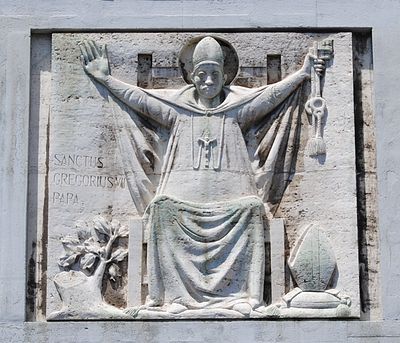
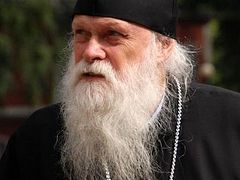

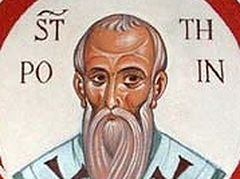
This article's speculation as to the effects of the filioque was especially problematic.
"I think this article is radically simplistic, and I doubt it will be helpful in advancing the true needs of the Church at this time. While I agree the Western developments did cause the split I think the overinflated hyperbole of this article does not capture the problems very well."
Justin,
Can you recommend another brief summary that better illustrates what you feel is lacking in this article?
Thank you.
Wonderful commentary - thank you!